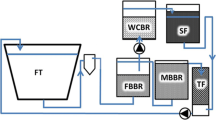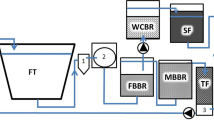Abstract
Pond water in intensive shrimp ponds is typically high in nutrients, solids, and BOD and may have an adverse environmental impact when discharged to natural waters. As part of ongoing research to develop intensive production technologies that minimize the potential for environmental impact, a study investigated the effect of lowrate, coarse-grain sand filtration on the quality of effluent being discharged from an intensive shrimp pond receiving 5% d−1 water exchange. The effect of sand filtration on a recirculating no-exchange pond was also examined. For comparison, a third pond received no water exchange and no filtration. Sand filtration removed some particulate matter, but levels of dissolved and particulate organic and inorganic nutrients were changed little and were sometimes higher as the result of in situ decomposition. Low-rate sand filtration is not seen as a cost-effective method of increasing the carrying capacity of no-exchange shrimp ponds or drastically improving the effluent quality of ponds with water exchange. Compared to previous studies with decreased or no water exchange, the application of feed in these ponds was more stable with small portions fed at frequent intervals with a constant rate of 80 kg ha−1 d−1. These ponds, stocked with 40 m−2 juvenilePenaeus vannamei, had excellent survival and normal growth, resulting in productions levels approaching 7,000 kg ha−1 crop−1 without water exchange. This indicates that intensive shrimp farming may be possible in static no-exchange systems, thereby minimizing the potential impact of effluent as long as feed inputs do not overwhelm the assimilative capacity of the pond ecosystem. *** DIRECT SUPPORT *** A01BY069 00011
Similar content being viewed by others
Literature Cited
American Public Health Association, American Water Works Associa, andWater Pollution Control Federation. 1989. Standard Methods for the Examination of Water and Wastewater 17th edition. American Public Health Association, Washington, D.C.
Anderson, J. M. 1987. Production and decomposition in aquatic ecosystems and implications for aquaculture, p. 123–147.In D. J. W. Moriarty and R. S. V. Pullin (eds.), Detritus and Microbial Ecology in Aquaculture. ICLARM Conference Proceedings 14, International Center for Living Aquatic Resource Management, Manila, Philippines.
Boyd, C. E. andY. Music. 1992. Shrimp pond effluents: Observations of the nature of the problem on commercial farms, p. 195–197.In J. A. Wyban (ed.), Proceedings of the Special Session on Shrimp Farming. World Aquaculture Society, Baton Rouge, Louisiana.
Brune, D. E. andC. M. Drapcho. 1991. Fed pond aquaculture, p. 15–33.In Aquaculture Systems Engineering: Proceedings of the World Aquaculture Society and the American Society of Agricultural Engineers Jointly Sponsored Session. American Society of Agricultural Engineers, St. Joseph, Michigan.
Hopkins, J. S. 1991. Status and history of marine and freshwater shrimp farming in South Carolina and Florida, p. 17–35.In P. A. Sandifer (ed.), Shrimp Culture in North America and the Caribbean. World Aquaculture Society, Baton Rouge, Louisiana.
Hopkins, J. S. 1992. Shrimp culture in the United States, p. 817–835.In A. W. Fast and L. J. Lester (eds.), Culture of Malishing Shrimp: principles and Practices. Elsevier Science Publishing Co., Amsterdam.
Hopkins, J. S. 1994. An apparatus for continuous removal of sludge and foam fractions in intensive shrimp ponds.Progressive Fish Culturist 56:135–139.
Hopkins, J. S., M. L. Baird, O. G. Grados, P. P. Maier, P. A. Sandifer, and A. D. Stokes. 1988. Impacts of intensive shrimp culture practices on the culture pond ecology, p. 40. Abstract 122.In 19th Annual Conference and Exposition, World Aquaculture Society, January 1988, Honolulu, Hawaii.
Hopkins, J. S., R. D. Hamilton, P. A. Sandifer, C. L. Browdy, and A. D. Stokes In press a. Effect of water exchange rates on production, water quality, effluent characteristics and nitrogen budgets in intensive shrimp ponds.Journal of the World Aquaculture Society
Hopkins, J. S., P. A. Sandifer, and C. L. Browdy. In press b. Sludge management in intersive pond culture of shrimp: effect of management regime on water quality, sludge characteristics, nitrogen extinction, and shrimp production.Aquacultural Engineering
Hopkins, J. S., P. A. Sandifer, A. D. Stokes, and C. L. Browdy. 1991. The effect of minimal water exchange on the water quality and production of intensive marine shrimp ponds, p. 33.In Program and Abstracts, 22nd Annual Confernce and Exposition, World Aquaculture Society. June 1991, San Juan, Puerto Rico.
Hopkin, J. S. andJ. Villalón. 1992. Synopsis of industrial panel input on shrimp pond management, p. 138–143.In J. A. Wyban (ed.) Proceedings of the special Session on Shirimp Farming. World aquaculture Scoeity, Baton Rouge, Louisiana.
Hurlbert, S. H. 1984. Pseudoreplication and the design of ecolocial field experiments.Ecological Monographs 54:187–211.
Pruder, G. D. 1992. Marine shrimp pond effluent: Characterization and environmental impact, p. 187–194.In: J. A. Wyban (ed.), Proceedings of the Special Session on Shrimp Farming. World Aquaculture Society, Baton Rouge, Louisiana.
Rosenberry, B. 1992. Destruction of mangroves and pollution are big problems for Thailand's shrimp farming industry.Aquaculture Digest 17:7–8.
Sandifer, P. A., J. S. Hopkins, andA. D. Stokes. 1987. Intensive culture potential ofPenaeus vannamei.Journal of the World Aquaculture Society 18:94–100.
Sandiffer, P. A., J. S. Hopkins, andA. D. Stokes. 1988. Internsification of shrimp culture in earthen ponds in South Carolina: Progress and prospects.Journal of the world Aquaculture Society 19:218–226.
Sandifer, P. A., J. S. Hopkins, A. D. Stokes, andG. D. Pruder. 1991a Technological advances in intensive pond culture of shrimp in the United States, p. 241–256.In P. DeLoach, W. J. Dougherty and M. A. Davidson (eds.) Forntiers in Shrimp Research. Elsevier Science Publishing Co. Amsterdam.
Sandifer, P. A., A. D. Stokes, J. S. Hopkins, andR. A. Smiley. 1991b. Further intensification of pond shrimp culture in South Carolina, p. 84–95.In: P. A. Sandifer (ed.), Shrimp Culture in North American and the Caribbean. World Aquaculture Society, Baton Rouge, Louisiana.
Steel, G. D. andJ. H. Horrie (eds.) 1988. Principles and Procedures of Statistics: A Biometrical Approach. Second Edition. McGraw-Hill, Book Co. New York.
Water Pollution Control Federation. 1988. Sludge Conditioning Manual of Practice No. FD-14. Water Pollution Control Federation, Alexandria, Virginia.
Weidner, D. andB. Rosenberry. 1992. World shrimp farming, p. 1–21.In J. A. Wyban (ed.) Proceedings of the Special Session on Shrimp Farming. World Aquaculture Society. Baton Rouge, Louisiana.
Ziemann, D., G. Pruder, and J-K. Wang. 1990. Aquaculture Effluent Discharge Program—Year 1 Final Report. Prepared for The Center for Tropical and Subtropical Aquaculture. Makapuu Point, Hawaii.
Author information
Authors and Affiliations
Rights and permissions
About this article
Cite this article
Hopkins, J.S., Browdy, C.L., Hamilton, R.D. et al. The effect of low-rate sand filtration and modified feed management on effluent quality, pond water quality and production of intensive shrimp ponds. Estuaries 18, 116–123 (1995). https://doi.org/10.2307/1352287
Received:
Accepted:
Issue Date:
DOI: https://doi.org/10.2307/1352287




